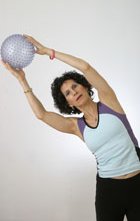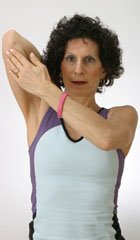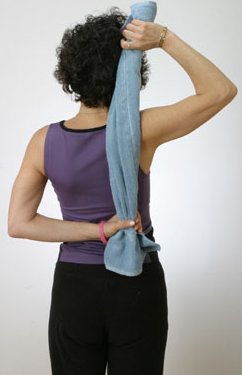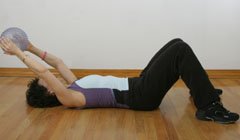 |
Rehabilitation for Breast Cancer Survivors
|
 It happens more than you think. You have received treatment for breast cancer including surgery, chemotherapy, and or radiation and your arm feels weak, tight, and is swollen and perhaps painful. No one told you
that you should exercise, what exercises to do or how to do them, but
you know that you need some guidance. Not only that, but you have
gained weight and feel tired. You don't feel like yourself. What should
you do? I am going to tell you about exercise and how important
exercise is in recovery. Unfortunately, physical recovery after breast
cancer treatment is not always addressed by medical professionals. That
is why you must advocate for your needs and find a trained
rehabilitation therapist who can assist you in meeting your post
treatment issues and goals. This article is going to be written in a
question and answer format. It is not intended to substitute for
medical advice. At the end, there will be a list of references that I
hope will be valuable. Please don't hesitate to contact me with more
questions, as they may be useful to others.
It happens more than you think. You have received treatment for breast cancer including surgery, chemotherapy, and or radiation and your arm feels weak, tight, and is swollen and perhaps painful. No one told you
that you should exercise, what exercises to do or how to do them, but
you know that you need some guidance. Not only that, but you have
gained weight and feel tired. You don't feel like yourself. What should
you do? I am going to tell you about exercise and how important
exercise is in recovery. Unfortunately, physical recovery after breast
cancer treatment is not always addressed by medical professionals. That
is why you must advocate for your needs and find a trained
rehabilitation therapist who can assist you in meeting your post
treatment issues and goals. This article is going to be written in a
question and answer format. It is not intended to substitute for
medical advice. At the end, there will be a list of references that I
hope will be valuable. Please don't hesitate to contact me with more
questions, as they may be useful to others.
 I have just received an axillary dissection and lumpectomy to my right breast. When should I begin exercise to that arm?
I have just received an axillary dissection and lumpectomy to my right breast. When should I begin exercise to that arm?
Once the drains are removed, one can begin light exercises to the
shoulder. However, be sure to wait until you have received doctors
permission. In
the interim, perform exercises to the elbow, wrist and hand such as
bending the elbow and straightening it, moving the wrist in clockwise
and counterclockwise circles and closing/opening your fist. Also, you
can squeeze a sponge. Try to perform 12 repetitions or one set of these
exercises once every hour or minimally a few times a day.
This will help to reduce swelling. Keep your arm elevated above the
heart with pillows at night. Exercises that promote range of motion to
the shoulder should be performed daily. If movement is too painful,
consult a physician who can refer you to a trained and licensed
occupational or physical therapist. Deep breathing exercises (see my Mind and Body page) are
a good place to start along with neck rolls and shoulder circles for
relaxation. Stretches to the axillary (armpit region where lymph nodes
are removed)and pectoralis (chest region where tissue removed) are most
important. This is where scar tissue is most likely to form. I
recommend stretching to the pectoralis, axillary and latissmus
musculature on a regular basis as scar tissue continues to form 1-2
years after surgery. Scar massage can help to break up adhesions which
can limit range of motion.
 What kind of flexibility exercises should I do?
What kind of flexibility exercises should I do?
If it is 1-3 weeks after surgery, I recommend using active assisted
exercises which use tools such as bars, balls, or towels to increase
shoulder range of motion and muscular flexibility. By using these
items, the stronger arm can help the weaker arm. Try to perform 12
repetititons of each exercise several times during the day. If that is
too much, start with a smaller number of repetitions and gradually
build up. Remember to focus on the shoulder, chest and armpit regions.
Be sure to start with good posture.
 Can I do aerobic exercise if undergoing chemotherapy?
Can I do aerobic exercise if undergoing chemotherapy?
Many studies have found that women who participate in aerobic training
sessions even while undergoing chemotherapy were able to sleep better,
were less tired, and had a better quality of life. It is best to start
slowly and at a low intensity. Bicycling, walking, or swimming are all
good places to start. Aim to do this type of exercise at least 3 times
per week. If you can only walk 5 minutes, start there. Gradually try to
increase the time to 10 minutes, then 15 minutes, and finally 30
minutes. Be sure to drink plenty of liquids to keep hydrated. It is
better to increase the duration and frequency of this type of exercise
rather than the intensity, meaning that you should increase the number
of times in a week that you do it rather than how hard you do it. Tip**
Get a pedometer and increase the number of steps you walk in a day.
Chemotherapy can affect blood counts so some activities may be off
limits ie swimming due to risk of infection or your bloods oxygen
transport ability. Be sure to check with your doctor regarding this
type of exercise when blood counts are taken. Finally, aerobic exercise
is contraindicated 24-48 hours after undergoing chemotherapy.
My shoulders are rounded since surgery. Can exercise help?
A good exercise program should address musculoskeletal imbalances.
After surgery, it is natural to protect the arm and the area operated
on. As a result, one tends to hunch over and baby the arm. Muscles
tighten including the pectoralis major, trapezius (upper back muscles)
and lats (muscle under the arm at ones side), while some muscles
stretch such as those in the back of the shoulder. Thus, it is
important to strengthen the rotator cuff of the shoulder and middle
back muscles and stretch the chest and side to obtain good posture.
Before you do any exercises, perform shoulder rolls to the back which
will help prepare your body for exercise. Make sure that your ears are
directly above your shoulders and that the head is not forward. Keep
your chest open by squeezing your shoulder blades together. Look into a
mirror to get an idea of your posture from both a front and side view.
Feel your chest stretching as your back works.
Reprinted by permission from
www.recovercisesforwellness.com
All of the photos are from
the CD RECOVERCISES : Exercise for Breast Cancer Survivors which can be ordered from this site.
References
Aaronson N (2000) Breast Cancer Recovery Exercise Program Desert Southwest Fitness Tucson, Arizona
Burt, J and White, G Lymphedema (1999) Hunter House Publishers Alameda, CA
Corneya,K Mackey, J and McKenzie, D Exercise for Breast Cancer
Survivors The Physician and Sports Medicine Vol. 30 No. 8 August 2002
Corneya, K Mackey, J and Jones,L Coping with Cancer -Can Exercise Help? The Physician and Sports Medicine Vol 28 No. 5 May 2000
Stumm,D Recovering from Breast Surgery (1995) Hunter House Publishers Alameda, CA